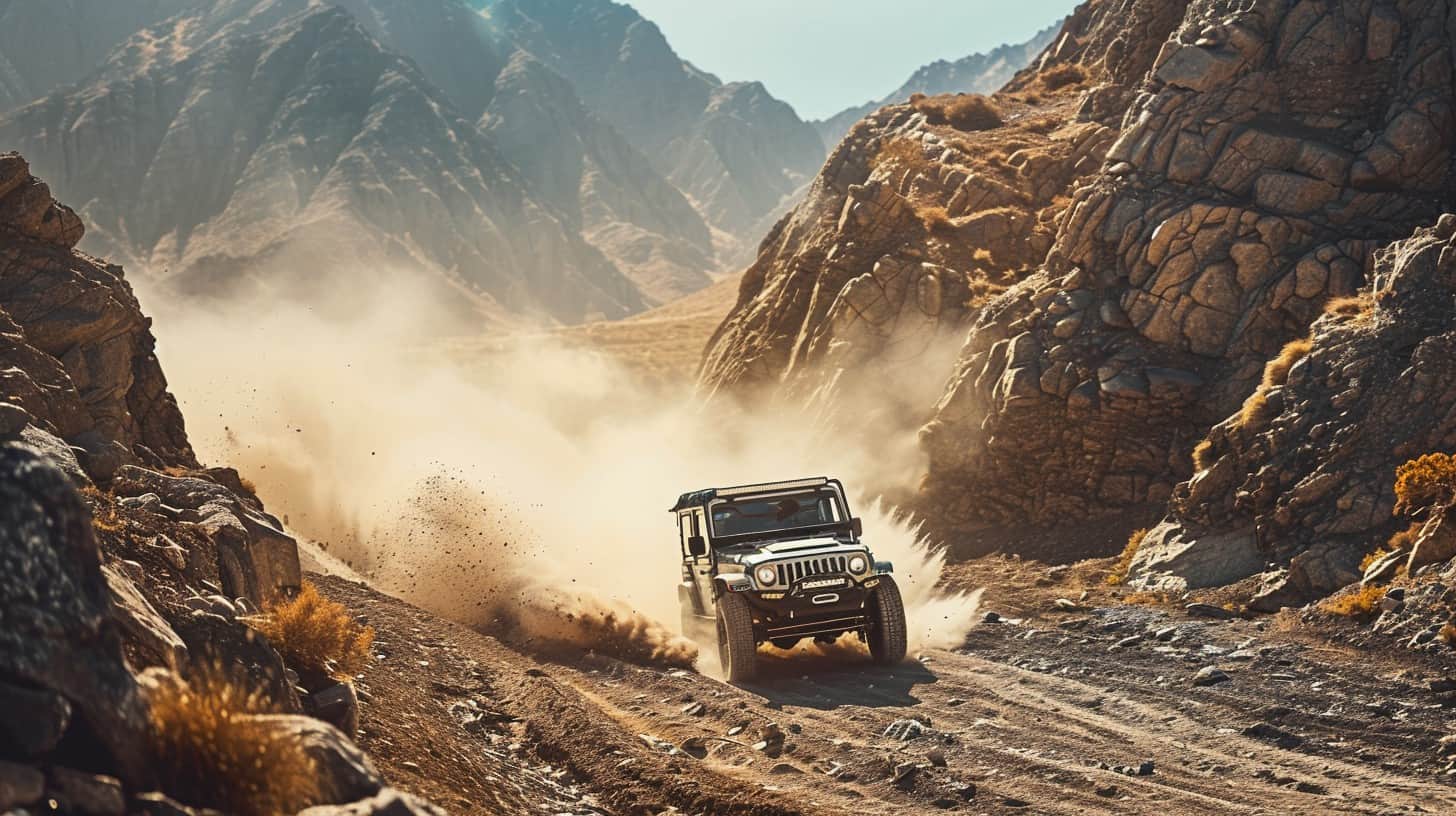Deciding between hitting the open road or tackling tough terrains? Here’s a fact: overlanding and off-roading cater to different kinds of adrenaline rushes. This article is your compass – guiding you through which path might rev up your wild side more.
Ready for an adventure?
Key Takeaways
Overlanding is about the journey, focusing on exploration and self-sufficiency over long distances. You might travel across countries or continents in a vehicle set up for living on the road, like trucks and SUVs equipped with camping gear and navigation tools.
Off-roading emphasizes challenging terrains for short-term thrills. It’s suited for those who seek adrenaline-pumping action through rock crawling, mudding, or dune bashing in specialized vehicles like ATVs or rugged jeeps.
Both adventures require specific gear; overlanders pack for survival and comfort (e.g., solar panels, portable fridges) while off-roaders focus on vehicle recovery and protection items (e.g., winches, skid plates).
Overlanding can last from a few days to years and requires extensive planning due to its nature of crossing various landscapes. In contrast, off-roading typically spans a day or two, allowing more spontaneity.
Choosing between overlanding and off-roading depends on what kind of adventure you’re after — whether it’s immersing yourself in diverse cultures and landscapes over time or conquering tough terrains for quick bursts of excitement.
Table of Contents
Understanding Overlanding
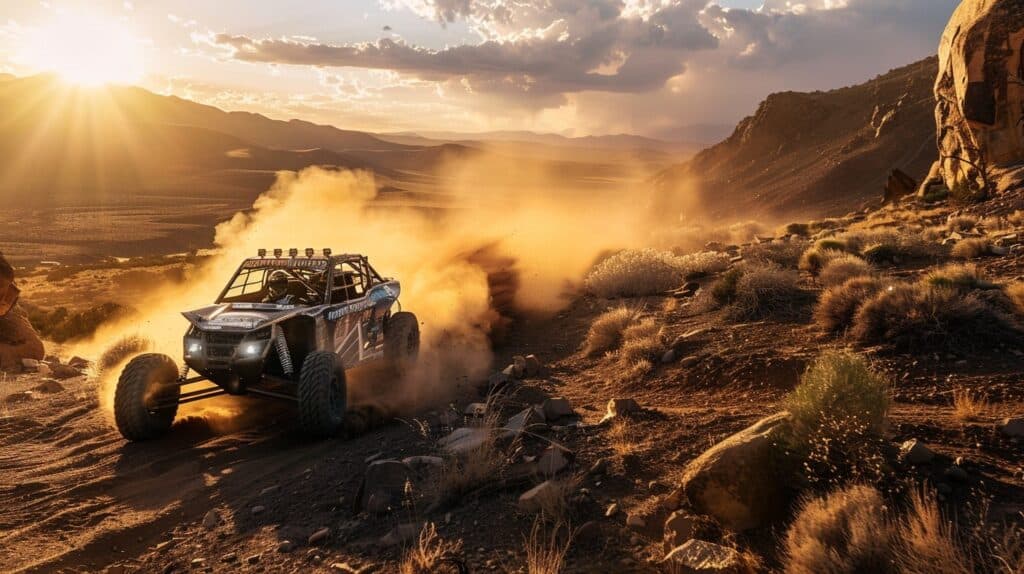
So, you think you’re ready to hit the wild? Overlanding is your ticket to adventure – not just a trip, but a journey across landscapes that change with every mile.
Purpose of Overlanding
Overlanding is for those who hear the call of the wild and answer with gusto. Picture yourself, your dream car garage finally making sense as you prep your vehicle – maybe one of those weird trucks or a beefed-up SUV equipped with solar panels.
This isn’t just a trip; it’s an expedition into the unknown. The aim? To explore remote areas where adventure waits around every bend, powered by self-sufficiency and resilience.
Imagine rolling out of bed, not in your luxury car garage but somewhere far off-grid, where each day brings a new horizon. You’re not just passing through; you’re soaking up every ounce of experience the journey offers — from rock crawling to navigating unpaved paths less traveled.
It’s about putting those all-terrain vehicles to test, living off campervans packed with everything from fridges powered by solar charging to battery packs ready for anything. Overlanding challenges you to become part explorer, part adventurer – always moving forward, thirsty for what lies beyond that next ridge.
Terrain and landscape in Overlanding
Traveling through different terrains and landscapes is the meat and potatoes of overlanding. You’ll find yourself cruising on smooth highways one moment and tackling rough, unmarked dirt paths the next.
Trees might canopy overhead in a dense forest, or you might be squinting against the glare of an open desert under the sun. This mix keeps things interesting – like flipping through channels, but way better because you’re actually living it.
Each landscape throws its own challenges and adventures at you. Think mud that tests your vehicle’s grip, sand that demands a delicate balance between power and finesse, or rocky trails that test your suspension’s mettle.
It’s not just about getting from point A to point B; it’s about how creatively and effectively, you navigate through all terrains — with a dash of fun thrown into the mix, of course.
Duration of Overlanding trips
Overlanding trips stretch anywhere from a weekend to years on end. Imagine hitting the road without a set return date, just you, your vehicle, and the great outdoors for company. This isn’t your average road trip; it’s an adventure where every day brings a new challenge, every sunset promises a different view.
You’ve got to pack like you’re moving out—because in a way, you are. Overlanders carry everything they need to live off-grid: solar generators for power, water filters for clean drinking water, and more survival gear than most of us have ever seen outside of an action movie.
Every inch of space counts because out there in the wilds, there’s no popping back home if you forget something crucial.
Vehicles used in Overlanding
After spending days, or even weeks, on the trail, the right vehicle becomes your home away from home. For Overlanding, think of trucks and SUVs that have room for sleeping bags, a portable fridge, maybe even a water heater for those chilly mornings at campsites.
These aren’t just any vehicles; these are beefed-up beasts with lift kits and tires ready to kiss the dirt goodbye. And let’s not forget about power – a lithium battery will keep those essential gadgets charged up in the middle of nowhere.
The cherry on top? An ARB air locker engages immediately at whatever speed you find yourself tackling tricky terrains. It’s like having superpowers when climbing steep hills or wading through rivers becomes part of your daily routine.
So grab an SUV or truck that doesn’t shy away from dirt bikes hitching a ride or has enough space to store all your camping gear – because out here, it’s not just about getting from A to B… it’s about how much fun you can pack into getting there.
Gear needed for Overlanding
Packing for overlanding is like preparing for a marathon, not a sprint. You’ll need solar generators and power stations because, let’s face it, nobody wants their food to go bad in the middle of nowhere if the fridge dies.
Portable fridges are your best friend here. Don’t forget navigation devices; getting lost isn’t as fun as movies make it seem. Throw in some recovery tools too—getting stuck with no way out can turn an adventure sour real fast.
Camping essentials are non-negotiables. After all, you’re not just driving; you’re living on the road. Your vehicle becomes your home, so equip it well. Think sleeping accommodations that don’t break your back and cooking gear that doesn’t make dinner taste like cardboard.
Remember, those long-term travels mean more than just scenery—they’re about comfort and readiness rolled into one rolling powerhouse… or should we say, home?
Understanding Off-Roading
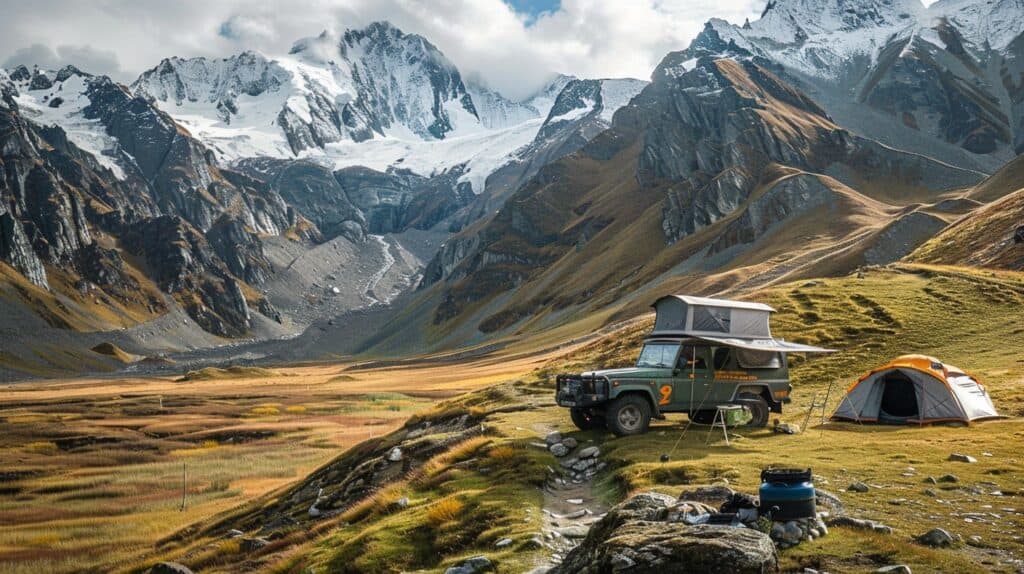
Off-roading is all about the thrill, folks. Imagine tearing through mud, bouncing over rocks, and feeling like a superhero in your rugged ride…
Purpose of Off-Roading
Off-roading is all about showing nature who’s boss with a beefy, mechanized beast. It’s taking on the world’s gnarliest terrains and coming out on top. Think mud-slinging action, rock-crawling adventure, and dune-bashing excitement—all in a day’s work for off-roaders.
The thrill? Unmatched. Off-road vehicles flex their muscles on these untamed landscapes, proving strength isn’t just for show.
It’s about pushing limits—both your own and your vehicle’s. Got a tough-as-nails ATV or a rugged Wrangler? Perfect—they’re built to conquer anything that comes their way. Whether it’s climbing steep hills or navigating through thick mud, off-roading turns every outing into an adrenaline-pumping quest.
And let’s not forget: it’s the ultimate test of skill for those behind the wheel… or handlebars!
Terrain and landscape in Off-Roading
Off-roading takes you through the wild and rugged. Picture a landscape where every turn is an adventure – from dune bashing in vast deserts to rock crawling on craggy terrains. These places challenge both man and machine, pushing them to their limits.
It’s not your average Sunday drive; think of it as a rollercoaster ride for grown-ups with all-terrain vehicles (ATVs) instead of carts.
Each path offers its own brand of thrill. Mud lovers dig mudding, while adrenaline junkies can’t get enough of desert racing or trialing competitions. The tougher the trail, the bigger the bragging rights.
And let’s not forget about those specifically altered “lifted” vehicles that look like they’ve been hitting the gym – because really, who doesn’t want their ride looking buff?
Duration of Off-Roading trips
Off-roading trips are quick adventures, usually lasting just a day or maybe stretching over a weekend. Think of it as grabbing your gear, jumping into your off-road vehicle, and hitting the local trails to blow off steam.
It’s about getting that thrill without taking too much time away from your busy schedule. You get to explore nature, push your vehicle to its limits, and still make it back in time for Monday morning.
These short bursts of adventure mean you can frequently enjoy them without needing extensive planning or vacation days. They’re perfect for those spontaneous moments when you’ve got a free Saturday and the weather’s just right.
Plus, they give you a fantastic opportunity to test out new gear—like that solar-powered generator or fast-charging power bank—without committing to a long haul in the wilderness.
Quick yet satisfying – that’s the beauty of off-roading trips.
Vehicles used in Off-Roading
Jumping from the duration of off-roading trips, let’s rev into what makes these adventures possible—vehicles built for the wild side. Off-roading beasts are not your average rides.
They’re crafted with strength and durability to conquer diverse road conditions. Think dune bashing in a hefty ATV or rock crawling with a rugged dirtbike. These machines eat rough terrains for breakfast.
From CUVs that glide over desert landscapes to campers equipped for long hauls in uncharted territories, the choice of vehicle matters as much as the destination. Each one is a powerhouse on wheels, designed to tackle anything from muddied paths to rocky inclines without breaking a sweat.
And let’s not forget about their recovery capabilities; getting stuck is just another opportunity for an adrenaline-fueled rescue operation. So grab your keys and pick your poison—offroading offers an electrifying escape no ordinary car can match.
Gear needed for Off-Roading
Pack a winch and some sturdy tow-ropes – they’re like the best pals that pull you out of tough spots. Don’t forget tire repair kits and air compressors; flat tires are part of the game, but they shouldn’t keep you off the trail for long.
Always throw in extra water and a reliable GPS because getting lost without backup is no joke. Protective gear for your ride, like brush guards and skid plates, keep it safe from belly scrapes or worse.
Recovery boards can be lifesavers on slippery mud or deep sand. And hey, those power banks? They’re not just for your phone – keeping essential gadgets charged can make all the difference between a great day out and an unwanted adventure.
Now, let’s move into understanding how these gear choices differ when we talk about overlanding…
Differences between Overlanding and Off-Roading
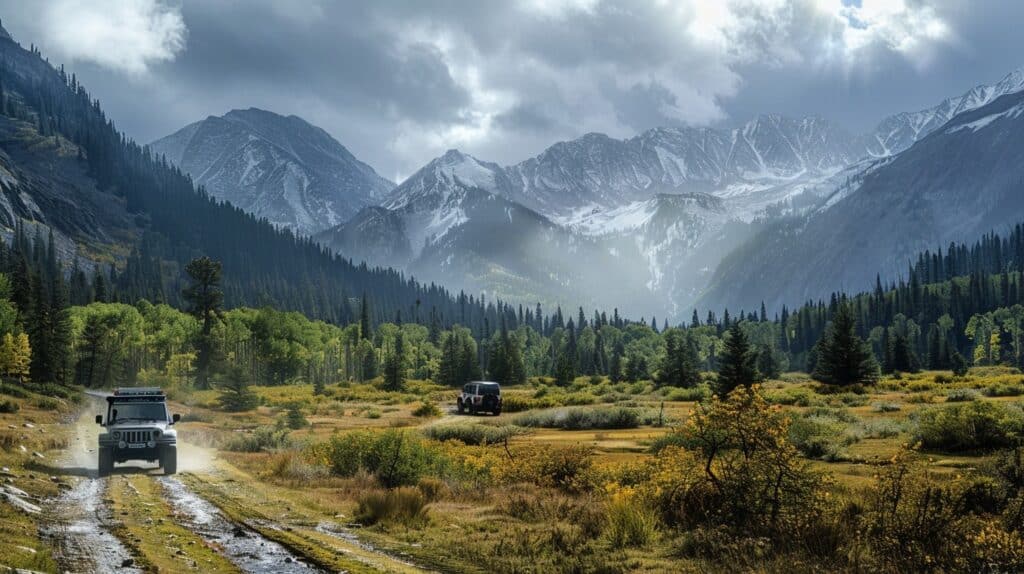
Overlanding is like taking the scenic route home, but your home is on wheels and the scenery lasts for days. Off-roading, on the other hand, is more like a wild roller coaster ride through nature’s backyard—fast, furious, and not for the faint of heart.
Difference in Purpose
So, let’s crack into the real meat of what sets overlanding apart from off-roading. Think of it as the difference between a marathon and a sprint – both are races, sure, but they’re playing on entirely different fields.
| Overlanding | Off-Roading |
|---|---|
| It’s all about the journey, not just the destination. | The thrill is in conquering tough terrains, not the miles covered. |
| Exploring new places is the name of the game. | It’s about testing your limits and your vehicle’s on gnarly trails. |
| You’re in it for the long haul, thinking days, even weeks on the road. | A day or two of adrenaline-fueled action is what you’re after. |
| Bringing cultures and nature closer is part of the adventure. | Overcoming obstacles, that’s the kind of personal achievement sought. |
In a nutshell, overlanding whispers tales of wanderlust, urging you to soak in every bit of the world at a pace that lets you savor every moment. Off-roading, on the other hand, shouts challenges – daring you to push boundaries and revel in the immediate thrill. Guess it boils down to what kind of wild you’re chasing – the serene or the extreme.
Difference in Terrain
Terrain talks volumes about what gets the adrenaline pumping for each adventurer. Overlanding lets you kiss the earth’s vastness, while off-roading is like arm-wrestling with Mother Nature’s toughest spots. Let me lay it out on the table – literally – so you can see what I mean.
| Aspect | Overlanding | Off-Roading |
|---|---|---|
| Terrain Type | Varied – from deserts to forests, mountains to plains. It’s about the journey, crossing multiple landscapes. | Challenging – think mud, rocks, sand dunes, and steep inclines. It’s all about testing limits on tough terrains. |
| Main Focus | Exploring remote areas, experiencing different cultures and landscapes. | Conquering difficult terrains for the thrill and challenge. |
| Travel Distance | Long distances, crossing countries or continents. | Shorter, focused on local trails or specific challenging areas. |
Overlanding whispers tales of diverse landscapes under your wheels. One day you’re sipping coffee by a serene lake, next you’re dusting off desert sands. It’s the variety pack of terrain experiences. On the flip side, off-roading’s like picking the double black diamond trail every time. It’s not just a trail; it’s a battle with nature’s harshest. You know, the kind where you’re left wondering if you’re driving the car or if it’s somehow driving you.
Either way, both paths promise adventure. Just depends on how you like your adrenaline served.
Difference in Duration
Time waits for no man, especially when you’re deciding between hitting the rugged trails for a day of off-roading or embarking on a cross-continental overlanding adventure. Let’s break it down, shall we? In the world of pushing limits and exploring the unknown, how long you’re gone matters just as much as where you go.
| Aspect | Overlanding | Off-Roading |
|---|---|---|
| Duration | From a few days to a few years. | Typically a day or a weekend. |
| Expedition Length | Weeks to years, crossing borders and continents. | Local trails for quick thrills. |
| Commitment | Long-term, immersive journey. | Short, adrenaline-filled escapes. |
| Planning | Extensive, covering routes, supplies, and visas. | Minimal, often spontaneous. |
Overlanding is a marathon, not a sprint. It’s about seeing how far you can go, both physically and mentally. On the flip side, off-roading is that heart-pumping burst of speed — a quick fix for those craving instant gratification.
Now, let’s talk about what you’ll be driving…
Difference in Vehicles used
Choosing the right chariot for your adventure isn’t just about horsepower or paint color. It’s like picking a dance partner for the rugged ballet of the outdoors. Overlanders and off-roaders, listen up, because this is where your paths diverge.
| Overlanding Vehicles | Off-Roading Vehicles |
|---|---|
| Built for the long haul, think of these as your home on wheels. Comfort and self-reliance are key. You’re likely to see rigs equipped with solar panels, a cozy spot for sleep, and even a kitchenette to whip up some wilderness gourmet. | These beasts are all about muscle and agility. It’s the strength and sturdiness that count here. Picture a vehicle that scoffs at boulders and laughs in the face of muddy pits. Recovery gear and protective add-ons are their armor in battling the elements. |
| Imagine SUVs and trucks modified to endure the trials of time and distance. They’re equipped to keep you comfortable, powered up, and ready for whatever the journey throws your way. Solar generators? Check. Portable fridge? Double check. | Think of specialized jeeps and trucks, often lifted, with tires that look like they could crush a coconut. These vehicles focus less on creature comforts and more on ensuring they can get you through the toughest, gnarliest terrain without a hiccup. |
Each path offers its own brand of thrill. So, whether you’re looking to make the wilderness your next zip code or just wanting to dominate the dirt, choose wisely. Now, let’s shift gears and weigh the pros and cons of each adventure style.
Difference in Gear needed
So, let’s talk gear. Whether you’re leaning towards overlanding or off-roading, the stuff you pack is going to be as different as night and day. Imagine setting off into the sunset, your vehicle loaded up – but is it with a portable fridge or a winch? That depends. Below, we’ve laid it out in black and white so you can see just what each wild ride requires.
| Overlanding | Off-Roading | |
|---|---|---|
| Gear Essentials | Camping necessities: Think tents, sleeping bags and cooking gear. You’re out for the long haul here.Solar panels and power stations: Keeping gadgets alive and kicking is key when you’re off-grid.Portable fridge: Because nobody likes warm beer or spoiled food.Navigation devices: Getting lost is not part of the plan. These help keep you on track.Recovery tools: For those “just in case” moments when terrain gets tricky. | Vehicle recovery items: Think winches, tow straps, and shovels. It’s about overcoming obstacles.Protective add-ons: Skid plates, roll cages, you name it. Your vehicle needs armor.Safety gear: Helmets, gloves, and perhaps even a fire extinguisher. Safety first, always.Heavy-duty tires: Those standard ones won’t cut it on rugged terrain.Fender flares: Because mud looks better on the trails than on your vehicle. |
Alright, now that you’ve got the lowdown on the gear, it’s easier to see how these adventures cater to different tastes. Overlanding whispers of long journeys and self-sufficiency, while off-roading shouts out the challenge of conquering tough terrains. Each has its charm, and well, its list of must-haves. Pack wisely, and you’re in for the time of your life.
Pros and Cons of Overlanding and Off-Roading
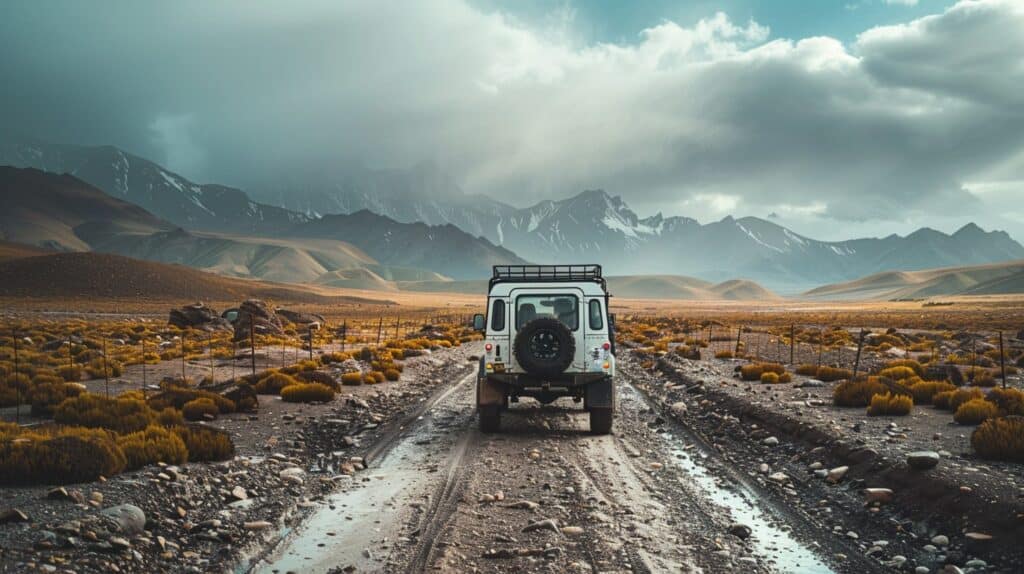
Thinking about overlanding and off-roading, huh? Well, each has its own set of goodies and baddies. Overlanding brings you closer to nature for longer, but it’ll test your patience with its slow pace.
Off-roading? It’s a thrill ride with all the bumps and jumps, yet it can be rough on both you and your vehicle. So, grab your gear – let’s dive deeper into what makes each tick…
Pros of Overlanding
Overlanding isn’t just a drive through the wild—it’s an epic tale of adventure. Here’s why you might prefer it over a weekend jaunt.
| Pro | Description |
|---|---|
| Embraces the Spirit of Exploration | You’re not just hitting the road. You’re chasing horizons, diving into cultures, and collecting stories worth telling. |
| Offers Cultural and Natural Experiences | It’s about the journey and the destinations. From mountains to deserts, overlanding pulls the world up close for a better look. |
| Suitable for Various Budgets | Think big or small—it’s flexible. You control the spend on gear, routes, and stays. It’s freedom with a steering wheel. |
| Combines Off-Road Exploration with Self-Reliant Living | Skills meet thrill. You navigate, camp, cook, and fix on the go. It’s living a life less ordinary, powered by self-sufficiency. |
So, with your wild side calling, overlanding offers an enticing mix of adventure, self-reliance, and cultural immersion. Next up, let’s shift gears and talk about off-roading—where the terrain gets tough, and the tough get going.
Cons of Overlanding
Planning an overlanding trip? Great idea, but let’s hit the brakes for a sec and look at the not-so-shiny parts. Here’s a no-frills breakdown:
| Con | Details |
|---|---|
| Significant planning needed | Packing up for an overlanding adventure isn’t a walk in the park. You’ll need to chart your course, prep your ride, and pack the right gear… and that’s just the start. |
| Potential isolation | Love the idea of being miles from civilization? Cool. But, if the thought of being far from a cold beer and a warm bed gives you the jitters, think twice. |
| Duration | Not everyone can ditch their day job to wander the wilderness. Long trips may clash with your 9-to-5. |
So, you’ve got the lowdown on the cons of overlanding. Now, let’s shift gears and check out off-roading’s ups and downs…
Pros of Off-Roading
Off-roading is more than just a test of your vehicle’s limits—it’s an adventure that promises adrenaline and freedom. Here’s a look at why you might want to consider giving it a go:
| Pros of Off-Roading |
|---|
| Thrilling Adventures |
| Connects you with nature in a raw, unfiltered way. |
| Builds skill in handling tough terrains. |
| Offers a unique social scene—bond with folks who get your thrill-seeking soul. |
| Enhances the bond between man and machine. You learn every rattle and hum of your ride. |
| It’s a chance to escape the mundane, everyday roads and hit landscapes where few dare to drive. |
| Offers genuine moments of triumph. Conquering a steep hill or navigating a tricky path is a rush. |
Let’s shift gears and look at what’s waiting for you on the flip side, shall we?
Cons of Off-Roading
So, we’ve explored the bright side of off-roading. Let’s pivot to some challenges.
Cons of Off-Roading
| Con | Explanation |
|---|---|
| Limited Travel Scope | Let’s face it, not all places welcome off-roaders with open arms. Your wild side might hit a boundary sooner than expected. |
| Risk of Vehicle Damage | Thrills come at a price. Dents, scratches, or worse could be parting gifts from your adventure. |
| High Modification Costs | Standard isn’t going to cut it. Prepping your ride for the wild can cost a pretty penny. |
| Environmental Concerns | Love Mother Nature? Off-roading can leave a mark on her, and not the good kind. |
| Legal Restrictions | Fun police alert! Some places have strict rules about where you can let loose. |
Zooming around uncharted terrains might sound like a blast, but it’s not all sunshine and rainbows. There’s a chance your beloved vehicle might come back looking like it’s been through a war zone. And, oh boy, fixing that won’t be cheap.
Also, remember the part about not all places being off-roader-friendly? Well, imagine gearing up for an epic adventure only to find a big “No Off-Roading” sign. Talk about a buzzkill.
Lastly, we’ve all heard the phrase, “Leave no trace.” Unfortunately, off-roading can make that a bit tricky. You wouldn’t want to be “that guy” who ruins it for everyone else, right?
So, while off-roading promises an adrenaline rush, it’s a bit like eating spicy food. Sure, it’s thrilling at first, but you might feel the burn later.
Deciding between Overlanding and Off-Roading
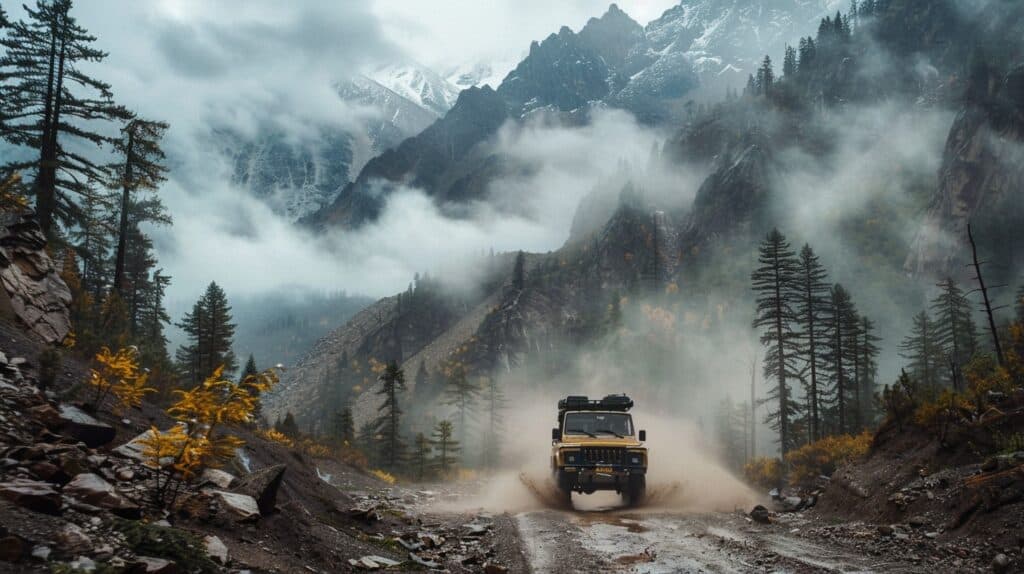
Your wild side is calling, but which call do you answer? Overlanding and off-roading both promise adventure, but they cater to different tastes. If the idea of being self-reliant on a cross-country expedition excites you, overlanding might be your jam.
You’ll need a vehicle that can handle both the weight and the distance—think solar power for energy-saving or Lifepo4 battery for backup power. This isn’t just a weekend getaway; it’s a lifestyle that could last from days to years.
On the flip side, if your adrenaline kicks in with challenging terrains, and you’re all about mastering tough landscapes within a shorter span—off-roading is where it’s at. Gear up your ATV or rig with fast-charging batteries and make sure your wheelbase can take on anything off-grid throws at you.
Whether it’s an afternoon tearing through mud or conquering rocky paths, off-roading offers bursts of thrill over quick distances. The question isn’t just about preference—it’s about what kind of explorer lives inside you.
FAQs About Overlanding vs Off-Roading
What’s the big deal about overlanding and off-roading?
Think of overlanding as the turtle, carrying its home everywhere, ready for a slow adventure. Off-roading? That’s the hare, zipping through mud and jumping hills for quick thrills. Both chase the wild, but in their own ways.
Can I go off-grid with these adventures?
Absolutely! Overlanding often means setting up camp where the map ends. With solar-powered generators and lithium-ion batteries for backup power, you’re good to go far from any plug-in spot. Off-roaders find joy in short bursts away from civilization—just make sure your ATV has enough juice!
Do I need a special vehicle?
You bet! Overlanders love rigs that can carry all their gear plus a kitchen sink (not really, but close). Think vehicles with room for fast charging stations and extra battery backups. Off-roaders prefer something that can handle a rally raid today and be back in time for dinner.
How about keeping my gadgets charged?
In both worlds, power storage is key. Solar panels on your roof rack or an extra lithium-ion pack will keep your cameras rolling and GPS logging in those “where am I?” moments.
Is it more than just driving around?
Oh, yes! It’s about cooking under stars miles from anywhere or finding that perfect hilltop sunrise after a bumpy ride—it’s electricity without needing an outlet! Whether you’re out there to chill or thrill, remember: it’s not just the destination; it’s every wild turn along the way.
